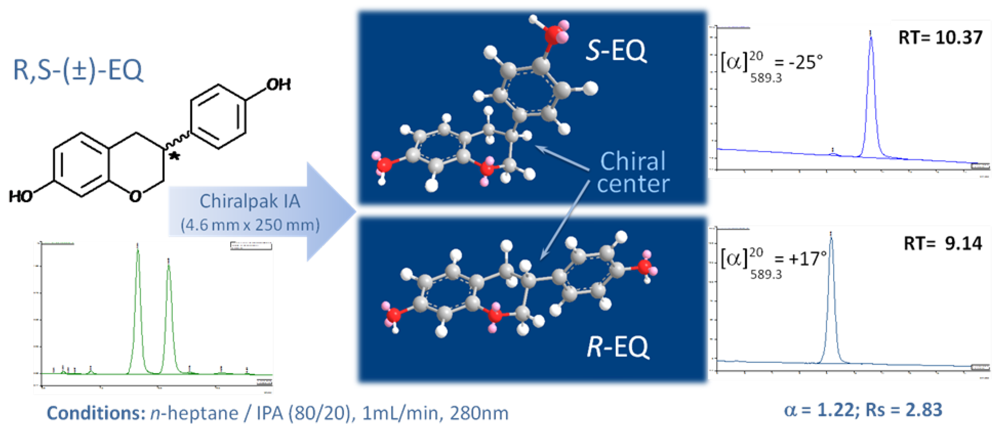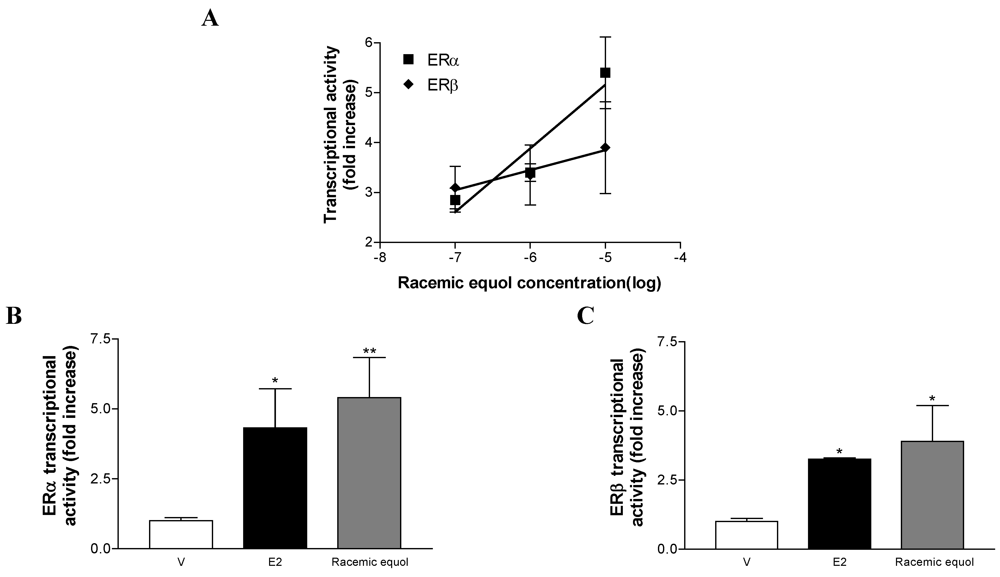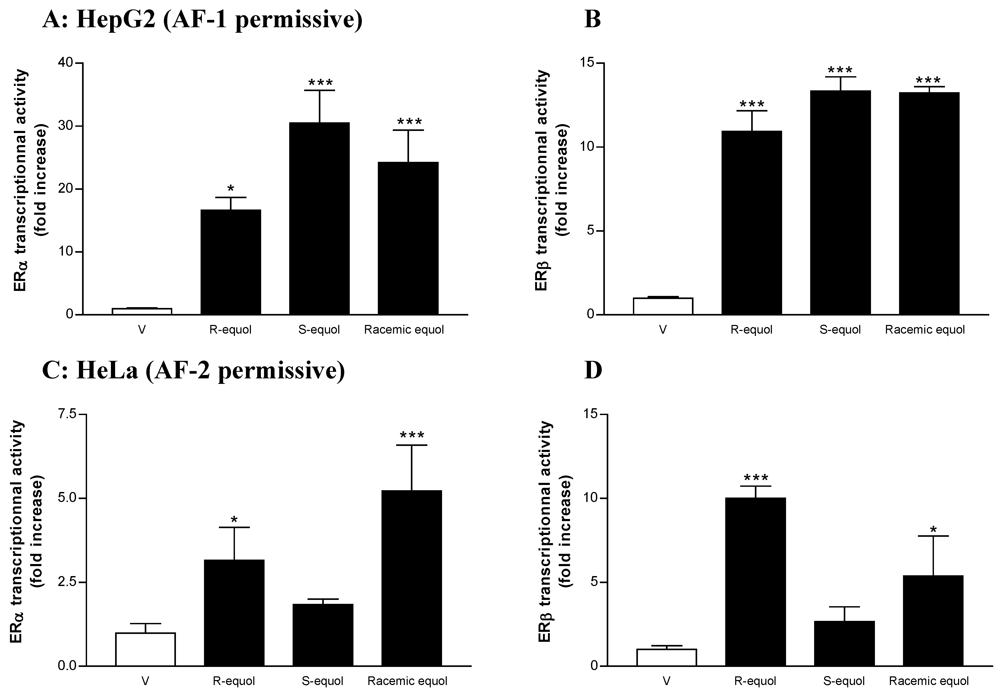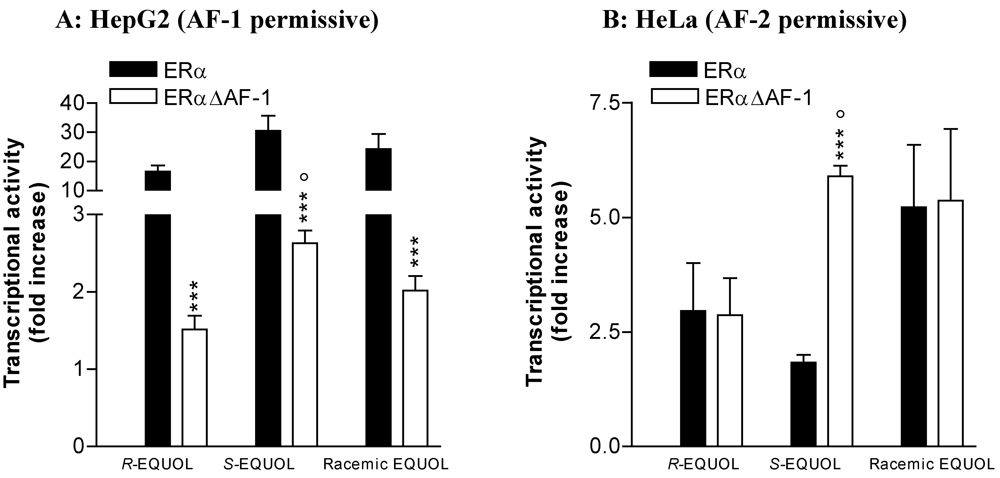Comparative Effects of R- and S-equol and Implication of Transactivation Functions (AF-1 and AF-2) in Estrogen Receptor-Induced Transcriptional Activity
Abstract
:Abbreviations
1. Introduction
2. Results and Discussion
2.1. Chemical Synthesis and Chiral Separation
| Eluent | Flow rate, mL/min | RT1 | RT2 | α | Rs |
| MeOH/TFA (99.9/0.9) | 0.5a | 18.59 | 20.32 | 1.11 | 1.27 |
| n-Heptane/EtOAc/TFA (85/15/0.1) | 1.0a | 34.56 | 40.13 | 1.18 | 2.58 |
| n-Heptane/DCM/IPA/TFA (50/47.5/2.5/0.1) | 1.0a | 27.94 | 32.04 | 1.17 | 3.09 |
| n-Heptane/IPA (80/20) | 1.0a | 9.14 | 10.37 | 1.22 | 2.83 |
| n-Heptane/IPA (80/20) | 3.0b | 13.41 | 15.17 | 1.17 | 3.92 |

2.2. Transcriptional Activation of ER by Different Enantiomeric Forms of Equol



3. Experimental Section
3.1. Chemicals and Instruments
3.2. Chemical Synthesis of (±)-Equol
3.3. Chromatographic Resolution of R- and S- equol.
3.4. Plasmids
3.5. Cell Culture and Transient Transfection Experiments
3.6. Statistical Analysis
4. Conclusions
Acknowledgements
References and Notes
- Mortensen, A.; Kulling, S.E.; Schwartz, H.; Rowland, I.; Ruefer, C.E.; Rimbach, G.; Cassidy, A.; Magee, P.; Millar, J.; Hall, W.L.; Kramer Birkved, F.; Sorensen, I.K.; Sontag, G. Analytical and compositional aspects of isoflavones in food and their biological effects. Mol. Nutr. Food Res. 2009, 53, S266–S309. [Google Scholar]
- Ishimi, Y. Soybean isoflavones in bone health. Forum Nutr. 2009, 61, 104–116. [Google Scholar]
- Steiner, C.; Arnould, S.; Scalbert, A.; Manach, C. Isoflavones and the prevention of breast and prostate cancer: new perspectives opened by nutrigenomics. Br. J. Nutr. 2008, 99, ES78–ES108. [Google Scholar]
- Bennetau-Pelissero, C.; Arnal-Schnebelen, B.; Lamothe, V.; Sauvant, P.; Sagne, J.L.; Verbruggen, M.A.; Mathey, J.; Lavialle, O. ELISA as a new method to measure genistein and daidzein in food and human fluids. Food Chem. 2003, 82, 645–658. [Google Scholar]
- Axelson, M.; Kirk, D.N.; Farrant, R.D.; Cooley, G.; Lawson, A.M.; Setchell, K.D.R. The identification of the weak estrogen equol [7-hydroxy-3-(4’-hydroxyphenyl)-chroman] in human urine. Biochem. J. 1982, 201, 353–357. [Google Scholar] [PubMed]
- Setchell, K.D.; Borriello, S.P.; Hulme, P.; Kirk, D.N.; Axelson, M. Nonsteroidal estrogens of dietary origin: possible roles in hormone-dependent disease. Am. J. Clin. Nutr. 1984, 40, 569–578. [Google Scholar]
- Atkinson, C.; Frankenfeld, C.L.; Lampe, J.W. Gut bacterial metabolism of the soy isoflavone daidzein: exploring the relevance to human health. Exp. Biol. Med. (Maywood) 2005, 230, 155–170. [Google Scholar] [PubMed]
- Yuan, J.P.; Wang, J.H.; Liu, X. Metabolism of dietary soy isoflavones to equol by human intestinal microflora--implications for health. Mol. Nutr. Food Res. 2007, 51, 765–781. [Google Scholar]
- Verbit, L.; Clark-Lewis, J.W. Optically active aromatic chromophores--VIII: Studies in the isoflavonoid and rotenoid series. Tetrahedron 1968, 24, 5519–5527. [Google Scholar]
- Setchell, K.D.R.; Clerici, C.; Lephart, E.D.; Cole, S.J.; Heenan, C.; Castellani, D.; Wolfe, B.E.; Nechemias-Zimmer, L.; Brown, N.M.; Lund, T.D.; Handa, R.J.; Heubi, J.E. S-equol, a potent ligand for estrogen receptor beta , is the exclusive enantiomeric form of the soy isoflavone metabolite produced by human intestinal bacterial flora. Am. J. Clin. Nutr. 2005, 81, 1072–1079. [Google Scholar] [PubMed]
- Lamberton, J.A.; Suares, H.; Watson, K.G. Catalytic hydrogenation of isoflavones. The preparation of (+)-equol and related isoflavans. Aust. J. Chem. 1978, 31, 455–457. [Google Scholar] [CrossRef]
- Wessely, F.; Prillinger, F. Constitution of equol. Ber. Dtsch. Chem. Ges. B 1939, 72B, 629–633. [Google Scholar]
- Muthyala, R.S.; Ju, Y.H.; Sheng, S.; Williams, L.D.; Doerge, D.R.; Katzenellenbogen, B.S.; Helferich, W.G.; Katzenellenbogen, J.A. Equol, a natural estrogenic metabolite from soy isoflavones: convenient preparation and resolution of R- and S-equols and their differing binding and biological activity through estrogen receptors alpha and beta. Bioorg. Med. Chem. 2004, 12, 1559–1567. [Google Scholar]
- Li, S.-R.; Chen, P.-Y.; Chen, L.-Y.; Lo, Y.-F.; Tsai, I.-L.; Wang, E.-C. Synthesis of haginin E, equol, daidzein, and formononetin from resorcinol via an isoflavene intermediate. Tetrahedron Lett. 2009, 50, 2121–2123. [Google Scholar]
- Gharpure, S.J.; Sathiyanarayanan, A.M.; Jonnalagadda, P. o-Quinone methide based approach to isoflavans: application to the total syntheses of equol, 3'-hydroxyequol and vestitol. Tetrahedron Lett. 2008, 49, 2974–2978. [Google Scholar]
- Wang, X.-L.; Hur, H.-G.; Lee, J.H.; Kim, K.T.; Kim, S.-I. Enantioselective synthesis of S-equol from dihydrodaidzein by a newly isolated anaerobic human intestinal bacterium. Appl. Environ. Microbiol. 2005, 71, 214–219. [Google Scholar]
- Setchell, K.D.R.; Cole, S.J. Compositions and products containing S-equol, and methods for their making. U.S. Pat. Appl. Publ. 20040235758, 2004. [Google Scholar]
- Heemstra, J.M.; Kerrigan, S.A.; Doerge, D.R.; Helferich, W.G.; Boulanger, W.A. Total Synthesis of (S)-Equol. Org. Lett. 2006, 8, 5441–5443. [Google Scholar]
- Takashima, Y.; Kaneko, Y.; Kobayashi, Y. Synthetic access to optically active isoflavans by using allylic substitution. Tetrahedron 2010, 66, 197–207. [Google Scholar]
- Setchell, K.D.R.; Sorokin, V.D. Method for enantioselective hydrogenation of chromenes. U.S. Pat. Appl. Publ 20070027329, 2007. [Google Scholar]
- Setchell, K.D.R.; Cole, S.J. Compositions and products containing R-equol, and methods for their making. U.S. Pat. Appl. Publ. 20040147594, 2004. [Google Scholar]
- Magee, P.J.; Raschke, M.; Steiner, C.; Duffin, J.G.; Pool-Zobel, B.L.; Jokela, T.; Wahala, K.; Rowland, I.R. Equol: a comparison of the effects of the racemic compound with that of the purified S-enantiomer on the growth, invasion, and DNA integrity of breast and prostate cells in vitro. Nutr. Cancer 2006, 54, 232–242. [Google Scholar] [CrossRef] [PubMed]
- Kuiper, G.G.; Lemmen, J.G.; Carlsson, B.; Corton, J.C.; Safe, S.H.; van der Saag, P.T.; van der, B.B.; Gustafsson, J.A. Interaction of estrogenic chemicals and phytoestrogens with estrogen receptor beta. Endocrinology 1998, 139, 4252–4263. [Google Scholar]
- Metivier, R.; Penot, G.; Flouriot, G.; Pakdel, F. Synergism between ERalpha transactivation function 1 (AF-1) and AF-2 mediated by steroid receptor coactivator protein-1: requirement for the AF-1 alpha-helical core and for a direct interaction between the N- and C-terminal domains. Mol. Endocrinol. 2001, 15, 1953–1970. [Google Scholar]
- Pelissero, C.; Bennetau, B.; Babin, P.; Le Menn, F.; Dunogues, J. The estrogenic activity of certain phytoestrogens in the Siberian sturgeon Acipenser baeri. J. Steroid Biochem. Mol. Biol. 1991, 38, 293–299. [Google Scholar]
- Zhang, T.; Kientzy, C.; Franco, P.; Ohnishi, A.; Kagamihara, Y.; Kurosawa, H. Solvent versatility of immobilized 3,5-dimethylphenylcarbamate of amylose in enantiomeric separations by HPLC. J. Chromatogr. A 2005, 1075, 65–75. [Google Scholar]
- Mathey, J.; Lamothe, V.; Coxam, V.; Potier, M.; Sauvant, P.; Pelissero, C.B. Concentrations of isoflavones in plasma and urine of post-menopausal women chronically ingesting high quantities of soy isoflavones. J. Pharm. Biomed. Anal. 2006, 41, 957–965. [Google Scholar]
- Vergne, S.; Titier, K.; Bernard, V.; Asselineau, J.; Durand, M.; Lamothe, V.; Potier, M.; Perez, P.; Demotes-Mainard, J.; Chantre, P.; Moore, N.; Bennetau-Pelissero, C.; Sauvant, P. Bioavailability and urinary excretion of isoflavones in humans: effects of soy-based supplements formulation and equol production. J. Pharm. Biomed. Anal. 2007, 43, 1488–1494. [Google Scholar]
- Setchell, K.D.; Zhao, X.; Jha, P.; Heubi, J.E.; Brown, N.M. The pharmacokinetic behavior of the soy isoflavone metabolite S-(-)equol and its diastereoisomer R-(+)equol in healthy adults determined by using stable-isotope-labeled tracers. Am. J. Clin. Nutr. 2009, 90, 1029–1037. [Google Scholar]
- Carreau, C.; Flouriot, G.; Bennetau-Pelissero, C.; Potier, M. Respective contribution exerted by AF-1 and AF-2 transactivation functions in estrogen receptor alpha induced transcriptional activity by isoflavones and equol: consequence on breast cancer cell proliferation. Mol. Nutr. Food Res. 2009, 53, 652–658. [Google Scholar]
- Mueller, S.O.; Simon, S.; Chae, K.; Metzler, M.; Korach, K.S. Phytoestrogens and their human metabolites show distinct agonistic and antagonistic properties on estrogen receptor alpha (ERalpha) and ERbeta in human cells. Toxicol. Sci. 2004, 80, 14–25. [Google Scholar]
- Morito, K.; Hirose, T.; Kinjo, J.; Hirakawa, T.; Okawa, M.; Nohara, T.; Ogawa, S.; Inoue, S.; Muramatsu, M.; Masamune et, a. Interaction of phytoestrogens with estrogen receptors alpha and beta. Biol. Pharm. Bull. 2001, 24, 351–356. [Google Scholar]
- Kostelac, D.; Rechkemmer, G.; Briviba, K. Phytoestrogens modulate binding response of estrogen receptors alpha and beta to the estrogen response element. J. Agric. Food Chem. 2003, 51, 7632–7635. [Google Scholar]
- Berry, M.; Metzger, D.; Chambon, P. Role of the two activating domains of the oestrogen receptor in the cell-type and promoter-context dependent agonistic activity of the anti-oestrogen 4-hydroxytamoxifen. EMBO J. 1990, 9, 2811–2818. [Google Scholar]
- Fujita, T.; Kobayashi, Y.; Wada, O.; Tateishi, Y.; Kitada, L.; Yamamoto, Y.; Takashima, H.; Murayama, A.; Yano, T.; Baba, T.; Kato, S.; Kawabe, Y.; Yanagisawa, J. Full activation of estrogen receptor alpha activation function-1 induces proliferation of breast cancer cells. J. Biol. Chem. 2003, 278, 26704–26714. [Google Scholar]
- Gougelet, A.; Mueller, S.O.; Korach, K.S.; Renoir, J.M. Oestrogen receptors pathways to oestrogen responsive elements: the transactivation function-1 acts as the keystone of oestrogen receptor (ER) beta-mediated transcriptional repression of ERalpha. J. Steroid Biochem. Mol. Biol. 2007, 104, 110–122. [Google Scholar]
- Tzukerman, M.T.; Esty, A.; Santiso-Mere, D.; Danielian, P.; Parker, M.G.; Stein, R.B.; Pike, J.W.; McDonnell, D.P. Human estrogen receptor transactivational capacity is determined by both cellular and promoter context and mediated by two functionally distinct intramolecular regions. Mol. Endocrinol. 1994, 8, 21–30. [Google Scholar]
- Wu, F.; Safe, S. Differential activation of wild-type estrogen receptor alpha and C-terminal deletion mutants by estrogens, antiestrogens and xenoestrogens in breast cancer cells. J. Steroid Biochem. Mol. Biol. 2007, 103, 1–9. [Google Scholar]
- Yoon, K.; Pallaroni, L.; Stoner, M.; Gaido, K.; Safe, S. Differential activation of wild-type and variant forms of estrogen receptor alpha by synthetic and natural estrogenic compounds using a promoter containing three estrogen-responsive elements. J. Steroid Biochem. Mol. Biol. 2001, 78, 25–32. [Google Scholar]
- Huet, G.; Merot, Y.; Le Dily, F.; Kern, L.; Ferriere, F.; Saligaut, C.; Boujrad, N.; Pakdel, F.; Metivier, R.; Flouriot, G. Loss of E-cadherin-mediated cell contacts reduces estrogen receptor alpha (ER alpha) transcriptional efficiency by affecting the respective contribution exerted by AF1 and AF2 transactivation functions. Biochem. Biophys. Res. Commun. 2008, 365, 304–309. [Google Scholar]
- Merot, Y.; Metivier, R.; Penot, G.; Manu, D.; Saligaut, C.; Gannon, F.; Pakdel, F.; Kah, O.; Flouriot, G. The relative contribution exerted by AF-1 and AF-2 transactivation functions in estrogen receptor alpha transcriptional activity depends upon the differentiation stage of the cell. J. Biol. Chem. 2004, 279, 26184–26191. [Google Scholar]
- Carreau, C.; Flouriot, G.; Bennetau-Pelissero, C.; Potier, M. Enterodiol and enterolactone, two major diet-derived polyphenol metabolites have different impact on ERalpha transcriptional activation in human breast cancer cells. J. Steroid Biochem. Mol. Biol. 2008, 110, 176–185. [Google Scholar]
- Lampe, J.W. Is equol the key to the efficacy of soy foods? Am. J. Clin. Nutr. 2009, 89, 1664–1667. [Google Scholar] [CrossRef] [PubMed]
- Brown, N.M.; Belles, C.A.; Lindley, S.L.; Zimmer-Nechemias, L.; Zhao, X.; Witte, D.P.; Kim, M.O.; Setchell, K.D. The Chemopreventive Action of Equol Enantiomers in A Chemically-Induced Animal Model of Breast Cancer. Carcinogenesis 2010. [CrossRef]
- Ishiwata, N.; Melby, M.K.; Mizuno, S.; Watanabe, S. New equol supplement for relieving menopausal symptoms: randomized, placebo-controlled trial of Japanese women. Menopause 2009, 16, 141–148. [Google Scholar]
© 2010 by the authors; licensee Molecular Diversity Preservation International, Basel, Switzerland. This article is an open-access article distributed under the terms and conditions of the Creative Commons Attribution license (http://creativecommons.org/licenses/by/3.0/).
Share and Cite
Shinkaruk, S.; Carreau, C.; Flouriot, G.; Bennetau-Pelissero, C.; Potier, M. Comparative Effects of R- and S-equol and Implication of Transactivation Functions (AF-1 and AF-2) in Estrogen Receptor-Induced Transcriptional Activity. Nutrients 2010, 2, 340-354. https://doi.org/10.3390/nu2030340
Shinkaruk S, Carreau C, Flouriot G, Bennetau-Pelissero C, Potier M. Comparative Effects of R- and S-equol and Implication of Transactivation Functions (AF-1 and AF-2) in Estrogen Receptor-Induced Transcriptional Activity. Nutrients. 2010; 2(3):340-354. https://doi.org/10.3390/nu2030340
Chicago/Turabian StyleShinkaruk, Svitlana, Charlotte Carreau, Gilles Flouriot, Catherine Bennetau-Pelissero, and Mylène Potier. 2010. "Comparative Effects of R- and S-equol and Implication of Transactivation Functions (AF-1 and AF-2) in Estrogen Receptor-Induced Transcriptional Activity" Nutrients 2, no. 3: 340-354. https://doi.org/10.3390/nu2030340
APA StyleShinkaruk, S., Carreau, C., Flouriot, G., Bennetau-Pelissero, C., & Potier, M. (2010). Comparative Effects of R- and S-equol and Implication of Transactivation Functions (AF-1 and AF-2) in Estrogen Receptor-Induced Transcriptional Activity. Nutrients, 2(3), 340-354. https://doi.org/10.3390/nu2030340




